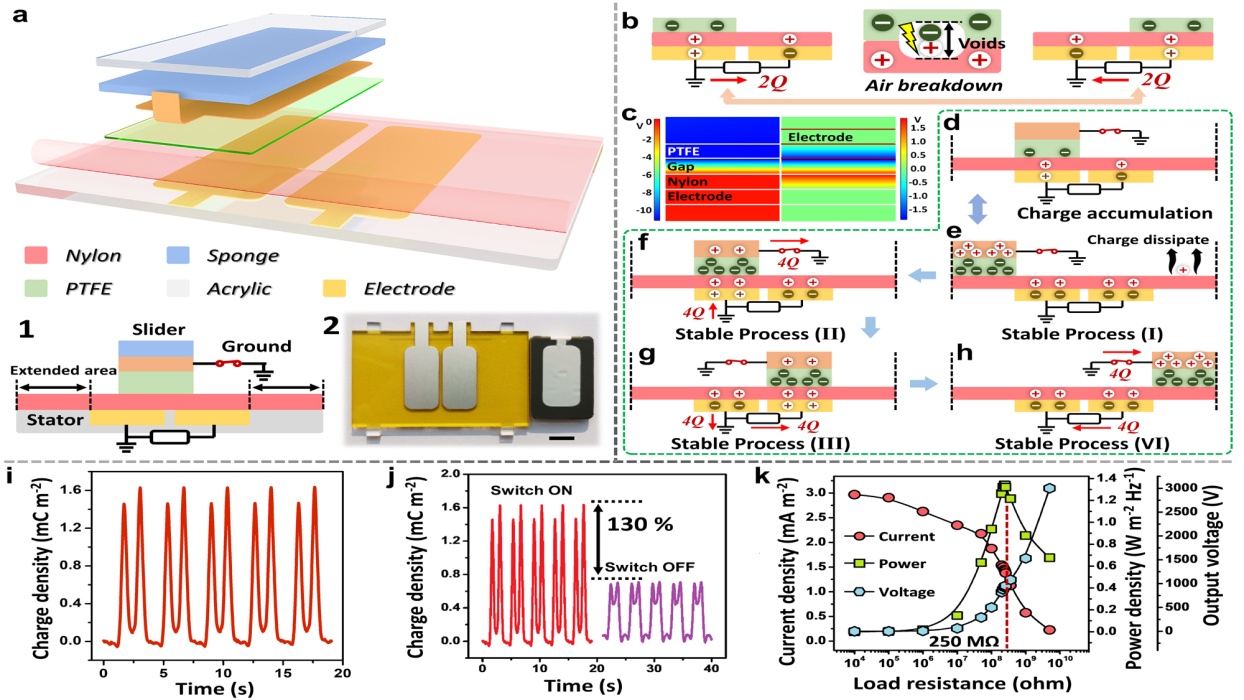On August 26, 2020, the research paper "Boosting output performance of sliding mode triboelectric nanogenerator by charge space-accumulation effect" written by research group led by CQU's Prof. Hu Chenguo from the School of Physics was published in Nature Communications. Chongqing University is the first and the corresponding organization. Doctoral candidates He Wencong and Liu Wenlin of Chongqing University are first co-authors. Professor Hu Chenguo and Professor Guo Hengyu from Chongqing University are corresponding co-authors.
Harvesting energy from the ambient environment for self-powering distributed sensor networks has become a significant development direction in the Internet of Things(IoTs). Recently, based on the coupling of triboelectrification and electrostatic induction 5 , the triboelectric nanogenerator(TENG) with the advantages of light weight, material variety, easy fabrication and low cost is attracting great attention. Nevertheless, the low surface charge density is the bottleneck in the TENG output performance and its applications. To boost the output performance, numerous research works have been carried out for enhancing the surface charge density of CS-TENG, such as the inner material optimization, surface physical/chemical modification, ion injection, environmental control, etc. A record high charge density of 2.38 mCm −2 was achieved by charge excitation and quantifying contact in the latest work. However, as surface modification of tribo-materials and charge excitation strategies are not well applicable for this mode, output performance promotion of S-TENG has no breakthrough recently. Therefore, taking air breakdown into consideration, developing strategies for maximizing the surface charge density for S-TENG is highly desired.
Herein, we propose a new design of S-TENG, the charge spaceaccumulation S-TENG (CSA-S-TENG) for improving surface charge density. The theoretical mechanism of the charge transfer in each CSA-S-TENG cycle is proposed and analyzed. The factors that influence the effective charge density of CSA-S-TENG are systematically studied as well. Herein, this work propose a new strategy by designing shielding layer and alternative blank-tribo-area enabled charge spaceaccumulation (CSA) for enormously improving the charge density of S-TENG. The charge density of CSA-S-TENG achieves a 2.3 fold enhancement (1.63 mC m−2) of normal S-TENG in ambient conditions. This work provides a deep understanding of the working mechanism of S-TENG and an effective strategy for promoting its output performance.
Website link (https://doi.org/10.1038/s41467-020-18086-4)OPEN
This work was supported by the National Natural Science Foundation of China (NSFC) and the Fundamental Research Funds for the Central Universities.

Fig. Structure and mechanism of CSA-S-TENG. a The 3D schematic of CSA-S-TENG. Inset 1. Cross-section view shows the extended area structure and grounding electrode. Inset 2. Photograph of the device. The area of top electrode is 5 cm2. The effective area of the stationary part is 26 cm2. Scale bar:1 cm. b Working mechanism and air breakdown of traditional S-TENG. c Potential simulation of air gap existence in CSA-S-TENG with/without shielding electrode. d Schematic of CSA-S-TENG with the same charge distribution as traditional S-TENG in the initial stage. e Stable charge distribution of CSA-STENG after multiple sliding cycles; charge generated on extended area dissipates into air, due to that there is no back electrode below to bound charge.e–h Working mechanism and relative charge transfer quantity of CSA-S-TENG in four states during half working period. i The output charge density curve. j single electrode CSA-S-TENG with grounded switch OFF/ON. k Matching impendence measurement of CSA-S-TENG.

